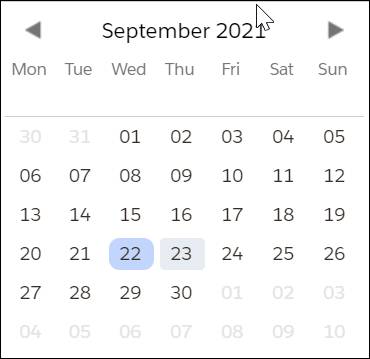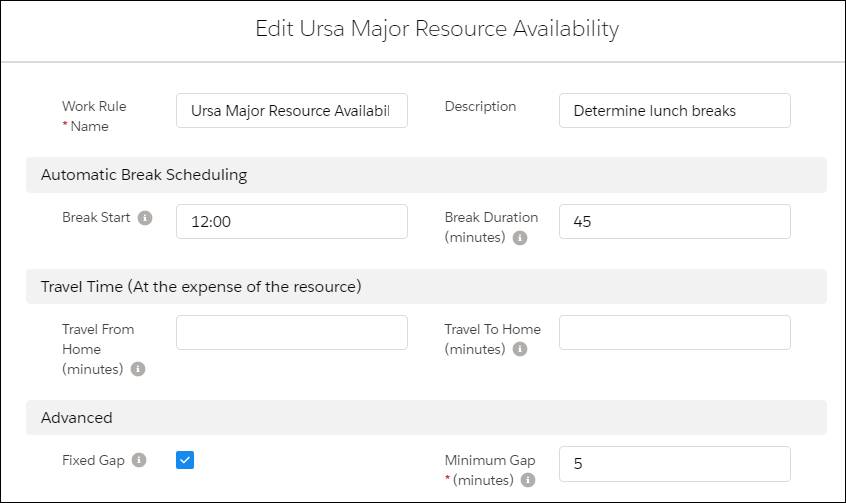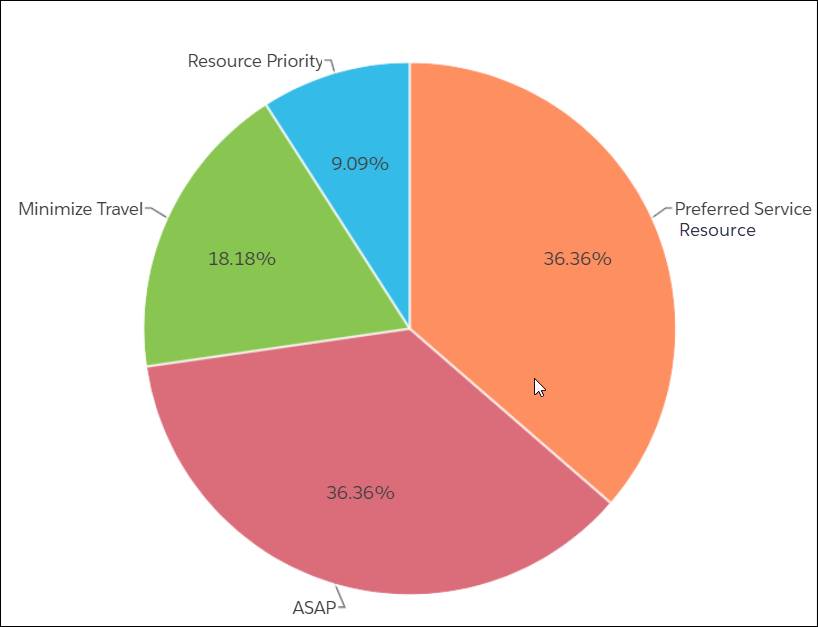Examine Scheduling Policies
Learning Objectives
After completing this unit, you’ll be able to:
- List the parts of a scheduling policy.
- Describe and create work rules.
- List and view service objectives.
Anatomy of a Scheduling Policy
Each scheduling policy is made up of work rules and service objectives. Work rules determine which candidates can complete the job. Do the candidates have the required skills? Are they available in the right territory at the right time? These kinds of questions eliminate unqualified candidates.
When you have a list of qualified candidates, service objectives use your business priorities to choose the best candidate for the job. For example, if your top priority is to minimize travel, the qualified candidate closest to the job site is the best choice.
Find Qualified Candidates with Work Rules
Remember the pass or fail grading system at school? Work rules assess mobile workers in a similar way. If a work rule specifies the Los Angeles territory, the scheduler asks: Does the candidate work in the Los Angeles territory? If no, they fail. If yes, they pass and are considered for a Los Angeles job.
The scheduler moves on to the next work rule. Does the candidate have the necessary skills to complete the job? If no, they fail and aren’t considered for the job. If yes, the candidate passes and the scheduler moves on to the next rule. Work rules reduce the pool of candidates from all possible mobile workers to just those who can do the job.
The managed package ships with several work rules. Some rules apply to candidates. For example, Match Skills ensures that a candidate is qualified to do the job. And Required Resource ensures that the specified worker works with a certain customer.
Some rules apply to time. Service Appointment Visiting Hours makes sure that the appointment is scheduled during a customer’s visiting hours. These are just a few examples. When you’re ready, explore the full list of standard work rules to see how they fit into your business.
If you schedule appointments automatically, your appointments always follow the work rules and all is well. But, if you schedule or reschedule appointments using drag and drop, they may violate work rules. For example, if you drag an appointment to a worker who doesn’t have a required skill, a rules violation occurs. A yellow triangle  appears on the Gantt next to the appointment with a rules violation. The dispatcher uses the dispatcher console to resolve the problem.
appears on the Gantt next to the appointment with a rules violation. The dispatcher uses the dispatcher console to resolve the problem.
Want to Get Hands-on with the Field Service Managed Package?
To follow along in this module, you need a special Developer Edition org that contains Field Service with the managed package and our sample data. Get the free Developer Edition and connect it to Trailhead now so you can follow along in your own org. Later, you use it to complete challenges. Note that this Developer Edition is designed to work with the challenges in this badge, and may not work for other badges. Always check that you’re using the Trailhead Playground or special Developer Edition org that we recommend.
- Sign up for a free Developer Edition org with Field Service.
- Fill out the form.
- For Email, enter an active email address.
- For Username, enter a username that looks like an email address and is unique. It doesn’t have to be a valid email account (for example, yourname@test.com).
- After you fill out the form, click Sign me up. A confirmation message appears.
- When you receive the activation email (this might take a few minutes), open it and click Verify Account.
- Complete your registration by setting your password and challenge question.
Tip: Write down your username, password, and login URL for easy access later.
- You’re logged in to your Developer Edition org.
Now connect your new Developer Edition org to Trailhead.
- Make sure you’re logged in to your Trailhead account.
- In the Challenge section at the bottom of this page, click the current playground name and then click Connect Org.
- On the login screen, enter the username and password for the Developer Edition you just set up.
- On the Allow Access? screen, click Allow.
- On the Want to connect this org for hands-on challenges? screen, click Yes! Save it. You're redirected back to the challenge page and ready to use your new Developer Edition to earn this badge.
Open the Gantt and view the sample data.
- From the App Launcher
 , find and select Field Service.
, find and select Field Service.
- Click the Field Service tab.
- In the calendar on the Gantt, choose September 22, 2021.

The sample data in this org runs from September 22, 2021, to September 24, 2021, so we go back in time for this module.
Create a Work Rule
If the standard rules don’t meet your needs, you can create one that does.
Ursa Major has discovered that sometimes it schedules mobile workers to work during their lunch break. That’s not OK.
- From the App Launcher
 , find and select Work Rules.
, find and select Work Rules.
- In the Work Rules tab, click New.
- Select the work rule’s record type. Maria selects Field Service - Service Resource Availability, and clicks Next.
- Define the work rule. Maria enters the following values.
- Name:
Ursa Major Resource Availability - Description:
Determine lunch breaks - Break start:
12:00 - Break duration:
45 - Select Fixed gap
- Minimum gap time:
5 - She leaves the other values blank.

- Click Save.
The new work rule appears in the list of available work rules. Later, Maria adds it to her scheduling policy to implement it.
Maria is familiar with the pass or fail world of work rules and how they narrow the list of candidates. But out of all the candidates who pass, which one is best for the job? That’s where service objectives come in.
Rank Candidates Based on Service Objectives
When the scheduler has a list of qualified candidates, the next step is to rank them and pick the best one. If rules are pass or fail, service objectives are more like numeric grades: They’re weighted from most to least important.
More important service objectives receive a higher weight than less important ones. Each candidate gets a score based on how well they meet each service objective. The scheduler tallies the scores and recommends the candidate with the highest score.
Here’s a list of service objectives the managed package provides. As with work rules, you can create service objectives when you need them.
Service Objective |
How It’s Used |
Example |
|---|---|---|
ASAP |
Measures how soon the appointment can be scheduled. ASAP is tricky, as it can contradict other objectives. For example, scheduling an appointment as soon as possible can result in more travel time. If prompt service is an important consideration, assign a high weight. |
If an appointment is scheduled at the earliest moment possible (closest to the earliest start permitted or arrival window start), it gets a perfect score of 100. If it's scheduled at the last slot before the due date or arrival window end, it gets a score of 0. |
Minimize Overtime |
Measures the use of overtime hours needed for a service appointment. It favors slots requiring the least overtime. If reducing overtime costs is an important consideration, assign a high weight. |
For an hour-long appointment:
|
Minimize Travel |
Measures travel time required for a service appointment. It favors the time slot requiring the least travel time. If reducing travel costs like mileage, gas, and service costs is an important consideration, assign a high weight. |
In optimization operations—global optimization, resource schedule optimization, in-day optimization, and the Reshuffle action—travel time is presumed to be between 0–120 minutes.
In non-optimization scheduling operations—such as the Book Appointment, Candidates, Schedule, Fill-In Schedule, and Group Nearby Appointments actions—the score is based on the travel times available. Travel is calculated linearly between the closest and the furthest travel. For an appointment with three scheduling options, here’s how the options are scored.
|
Preferred Resource |
Measures whether an appointment is given to the preferred mobile worker. If it’s important that the preferred mobile worker shows up, assign a high weight. If it’s critical that a certain worker shows up or stays away, use the Required Services or Excluded Services work rules. |
If an appointment is assigned to the preferred mobile worker, the score is 100. If it’s not, the score is 0. |
Resource Priority |
Ranks appointments based on the assigned mobile worker’s priority. |
A mobile worker with a value of 1 is rated the highest. Larger numbers indicate that the mobile worker has a lower score. |
Skill Level |
Measures how well a worker adheres to a work order’s skill requirement. Specify whether to favor the least- or most-qualified mobile worker. Use this option to assign your most qualified workers to complicated work or high-priority accounts. |
If you choose the least-qualified skill level, the candidate with the lowest acceptable score for the skill wins. Let’s say that an acceptable installation skill level is 5. A mobile worker with an installation skill of 6 gets a higher score than a worker with an installation skill of 8. Most-qualified is the opposite. The candidate with the installation skill of 8 gets the higher score. If there are multiple skill levels, the score is calculated with the average score of each skill level. |
Maria understands how service objectives map to Ursa Major’s business priorities. She’s ready to check out the weighting that her Ursa Major Customer First scheduling policy uses.
- From the App Launcher
 , click the Field Service Admin tile.
, click the Field Service Admin tile.
- Click the Field Service Settings tab and click Go to Guided Setup.
- If Guided Setup checks permissions sets, click Go to Guided Setup again.
- Click Customize Scheduling Policies.
- Click the scheduling policy. Maria clicks Customer First.
Maria scrolls to the Service Objectives section and examines the values for each service objective. The pie chart makes it easy to see how they compare to each other. Maria has modified her service objectives, so they may not look the same as yours.

To change the weight of a service objective, move its slider. For now, Maria leaves the values as they are.
In this unit, Maria learned that scheduling policies are made up of strictly enforced work rules and weighted service objectives. She checked out the list of standard rules and created one. Then she examined the values for the service objectives in a scheduling policy.
Resources
- Video: Work Rules in Field Service
- Video: Service Objectives in Field Service
- Salesforce Help: Create and Manage Work Rules
- Salesforce Help: Create and Manage Service Objectives